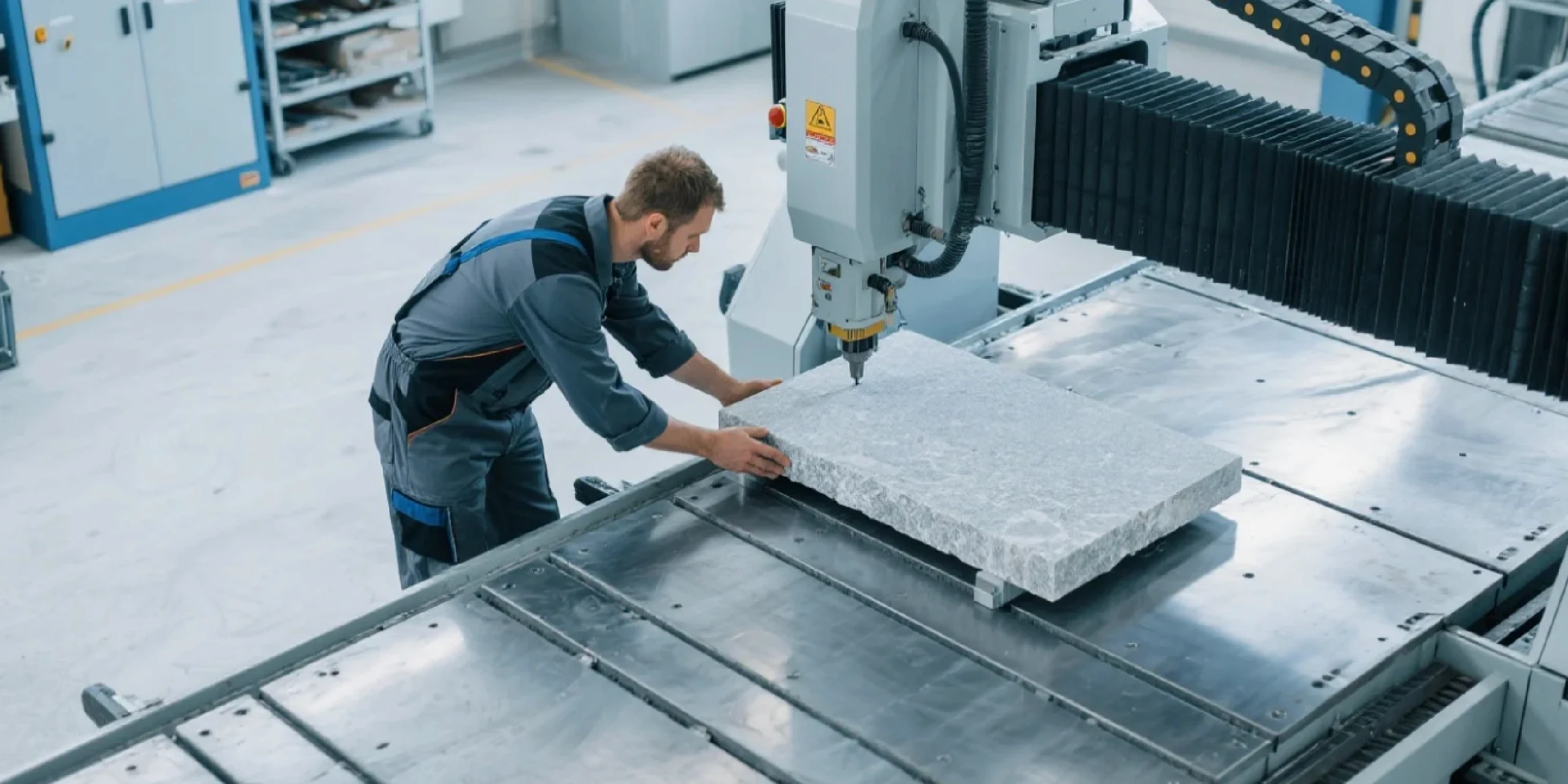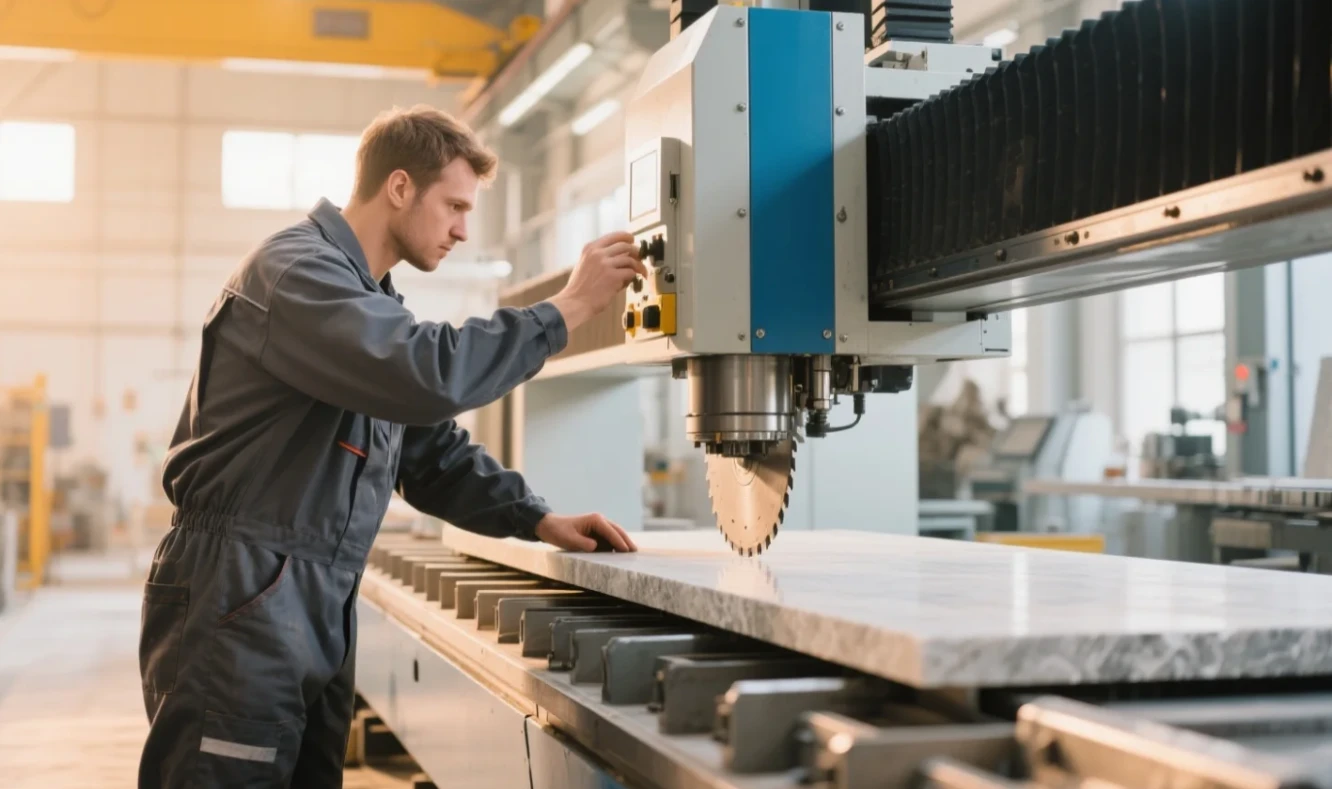Hi, this is Lizzy from Dinosaw ( Not a Robot ). Which Machine ( model ) do you want? Please WhatsApp us now
Discover the massive machines that slice through solid rock like butter. From quarry giants to factory workhorses, here's everything you need to know about heavy-duty stone cutting equipment.
Size matters in stone processing-but not for the reasons you might think. When you're dealing with 50-ton granite blocks fresh from the quarry, you need specialized giants that can slice through solid rock without breaking a sweat. These aren't your typical CNC machines; they're purpose-built monsters that transform raw quarry blocks into polished slabs forming the backbone of modern construction.
This guide cuts through the marketing fluff to focus on what really matters: power, capability, and bottom line impact. Whether you're running a quarry or managing a slab facility, understanding these industrial giants is crucial for staying competitive.
Ready to find the right equipment for your operation? Contact DINOSAW experts today for personalized guidance on choosing the perfect stone cutting solution.

What Actually Makes a Stone Saw "The Largest"?
Here's the thing about "largest" in stone cutting-it's not just about physical size. Three factors really define these industrial giants.
Blade Size Determines Everything
Blade diameter tells the whole story. A larger blade cuts deeper and wider in a single pass. That's critical when you're processing massive blocks straight from the quarry.
Think about it this way: a 6-foot diameter blade can slice through enormous granite blocks that would require multiple passes with smaller equipment. Time saved equals money earned.
Power Output Separates Winners from Losers
Raw horsepower drives success. The biggest blades in the world are useless without the muscle to push them through solid rock.
High-end machines pack 200+ horsepower motors. That kind of power maintains consistent speed even when cutting through the hardest granite or engineered quartz. No stalling. No blade binding. Just smooth, profitable cuts all day long.
Machine Footprint and Foundation Requirements
These machines are infrastructure investments. We're talking about equipment that weighs 20-30 tons and requires reinforced concrete foundations.
The physical footprint often determines what's possible in your facility. But that massive weight? It's actually a feature. Heavier machines stay stable during intense cutting operations, which means better cut quality and longer blade life.
The Biggest Quarry Machines: 3 Types That Dominate Block Cutting
Quarry operations need different capabilities than factory processing. These machines handle raw material fresh from the earth.
Multi-Wire Saws: The Undisputed Champions
Want to see something truly impressive? Multi-wire saws are the absolute giants of stone cutting.
Picture this: over 100 diamond wires working together, slicing through a massive quarry block like a hot knife through butter. One pass. Multiple slabs. That's efficiency.
The largest models can process blocks weighing several hundred tons. They turn one enormous piece of stone into dozens of uniform slabs in a single day. No other technology comes close to this level of productivity.
These machines dominate quarry operations for one simple reason: they maximize the value extracted from every block. Less waste means more profit.

Heavy-Duty Bridge Saws for Precision Cuts
Sometimes you need surgical precision instead of pure volume. That's where massive bridge saws shine.
These are essentially giant circular saws on steroids. The largest versions mount blades several meters in diameter on rigid steel frames. They make the initial cuts that prepare blocks for multi-wire processing.
Bridge saws excel at complex cutting patterns. Need to split a block at a specific angle? No problem. Want to remove a section with natural defects? Easy work for these precision giants.
Gang Saws: High-Volume Workhorses
Gang saws have been around forever, but modern versions are technological marvels.
They use multiple parallel blades to slice blocks into slabs. The key advantage? Consistent thickness across every slab with minimal material waste.
Large gang saws can handle blocks up to 3 meters wide and several tons in weight. They're perfect for operations that need uniform slabs rather than custom cuts.
Factory Processing Giants: Automation is Everything
Factory processing is all about speed and consistency. These machines work with pre-cut slabs, performing final sizing and finishing operations.
Automated Multi-Blade Systems
When it comes to factory processing, automation is everything.
Multi-blade cutters are like bridge saws on steroids. They can process multiple slabs simultaneously using programmable cutting patterns. The largest models handle 10+ slabs at once.
Think about the math: if you're processing 100 slabs per day manually, an automated system can triple that output with the same labor costs.
5-Axis CNC Systems for Complex Work
Not everything is about volume. Sometimes you need precision and flexibility.
5-axis CNC bridge saws represent the pinnacle of stone cutting technology. They move in five different directions, creating complex cuts, curves, and even three-dimensional shapes from flat slabs.
Companies like Dinosaw Machine have pushed this technology to new heights. Their advanced systems combine massive cutting capability with computer-controlled precision. Perfect for architectural projects that demand both size and complexity.
Large-Format Waterjet Tables
For intricate work, waterjet cutting is unbeatable.
These systems use high-pressure water mixed with abrasive materials to cut through stone with incredible precision. The largest waterjet tables accommodate enormous slabs while maintaining accuracy down to fractions of a millimeter.
Waterjet excels where traditional blades can't go. Complex curves, delicate materials, or intricate patterns-waterjet handles them all.
The Real Cost of Operating Industrial Giants
Here's what equipment dealers don't tell you upfront.
Total Cost of Ownership Goes Beyond the Price Tag
The sticker price is just the beginning. Smart buyers calculate the total cost of ownership (TCO) over 5-10 years.
Power consumption hits hard. Large motors can draw 200+ kilowatts continuously. That adds up fast when you're running 16-hour shifts.
Consumables are the hidden cost killer. Diamond blades for large saws can cost $5,000-15,000 each. Wire for multi-wire saws runs $50-100 per meter. These costs accumulate quickly in high-volume operations.
Water usage and disposal costs matter too, especially for waterjet systems that can consume thousands of gallons per day.
Maintenance Makes or Breaks Profitability
Preventive maintenance isn't optional-it's survival.
These machines demand daily attention. Lubrication, tension checks, alignment verification.
Skip these basics and you're looking at catastrophic failures that cost tens of thousands in repairs.
Smart operators establish relationships with manufacturers like Dinosaw Machine that provide comprehensive support programs. Having parts available immediately versus waiting weeks can make the difference between profit and loss.
Operator Skills Determine ROI
The best machine is worthless without skilled operators.
Running these giants requires real expertise. Proper blade selection, optimal cutting speeds, material handling techniques-these skills separate profitable operations from struggling ones.
Quality manufacturers provide comprehensive training programs. The investment in education pays dividends through improved productivity and reduced downtime.
How to Choose the Right Heavy-Duty Machine
Not all large machines are created equal. Your choice should match your specific needs.
Material Type Drives Equipment Selection
Different stones require different approaches.
Granite demands high power and aggressive blades. The hardness requires robust equipment that can maintain cutting speed without overheating.
Marble cuts more easily but chips if handled roughly. Machines for marble processing need precision and smooth operation rather than brute force.
Engineered quartz presents unique challenges. Its resin content generates heat during cutting, requiring specialized cooling systems and blade designs.
Production Volume Determines Machine Type
Match your equipment to your business model.
High-volume operations benefit from multi-wire saws or automated systems. The initial investment pays off through reduced labor costs and increased throughput.
Custom work requires flexibility. CNC systems cost more upfront but handle diverse projects that command premium pricing.
Mixed operations might need multiple machines working together. A bridge saw for initial cuts paired with a multi-blade system for volume processing.
Workflow Integration Is Critical
Think beyond individual machines to your entire production flow.
Material handling equipment needs to match your cutting capacity. What good is a high-speed saw if you can't feed it material fast enough?
Quality control systems should integrate with cutting operations. Automated inspection catches defects before valuable time is wasted on flawed pieces.
Finishing equipment must handle your cutting output. Bottlenecks anywhere in the process limit overall productivity.
What's Next: Future of Large-Scale Stone Cutting
The industry is evolving rapidly. Smart operators are preparing for what's coming.
AI and Automation Revolution
Artificial intelligence is transforming stone processing.
Modern systems analyze stone patterns and automatically optimize cutting paths. This reduces waste and maximizes yield from every block.
Predictive maintenance uses sensors to identify problems before they cause failures. Machines schedule their own service based on actual wear patterns rather than arbitrary timelines.
Robotic material handling allows 24/7 operation with minimal human intervention. Lights-out production is becoming reality in leading facilities.
Sustainability Drives Innovation
Environmental concerns are reshaping equipment design.
Water recycling systems reduce consumption by 90% or more. Closed-loop systems clean and reuse cutting fluids continuously.
Energy efficiency improvements lower operating costs while reducing environmental impact. Variable-speed drives and efficient motors cut power consumption significantly.
Waste reduction technologies squeeze more value from every block. Advanced optimization software minimizes offcuts and maximizes usable material.
Ready to Invest in Industrial-Grade Equipment?
Choosing the right heavy-duty stone cutting machine requires expertise and careful analysis.
At Dinosaw Machine, we don't just sell equipment-we provide complete solutions. Our range includes everything from multi-wire giants to precision CNC systems, all designed for maximum performance and profitability.
Our team analyzes your specific needs, material types, and production goals to recommend the optimal equipment configuration. We provide comprehensive training, ongoing support, and readily available parts to ensure your investment delivers long-term value.
Contact our experts today for a personalized consultation. Discover how the right equipment can transform your stone processing operation.
Frequently Asked Questions
What's the biggest stone cutting machine in the world?
There's no single "biggest" machine, but quarry multi-wire saws are among the largest. These giants can exceed 50 meters in length and process blocks weighing hundreds of tons. Their size reflects the massive scale required to handle raw materials straight from quarries.
How much do large-scale stone cutting machines cost?
Prices vary dramatically based on type and capability. Large bridge saws range from $50,000 to $200,000+. High-end multi-wire saws can exceed $500,000. Remember-the purchase price is just the beginning. Factor in installation, training, and ongoing operational costs for accurate budgeting.
What's the difference between wire saws and bridge saws?
Wire saws use diamond-embedded cables to slice through stone, making them ideal for large blocks and complex cuts. Bridge saws use circular blades mounted on movable frames, offering precision and versatility for slab processing. Each excels in different applications.
Can large saws cut any type of stone?
Not exactly. Stone hardness determines equipment requirements. Granite needs high-powered machines with aggressive cutting tools. Marble requires gentler handling to prevent chipping. Engineered materials present unique challenges. Choose equipment designed for your specific materials.
What maintenance do these machines require?
Daily maintenance includes lubrication, water system checks, and blade tension verification. Weekly tasks involve thorough cleaning and alignment checks. Professional inspections should occur monthly. Proactive maintenance prevents costly breakdowns and extends equipment life significantly.
What are the latest innovations in stone cutting?
AI-powered optimization software reduces waste by analyzing stone patterns and optimizing cutting paths. Robotic material handling enables 24/7 operation. Predictive maintenance uses sensors to prevent failures before they occur. These innovations are transforming the industry toward greater efficiency and automation.


























 English
English 中文
中文 Italian
Italian Türkçe
Türkçe Português
Português

